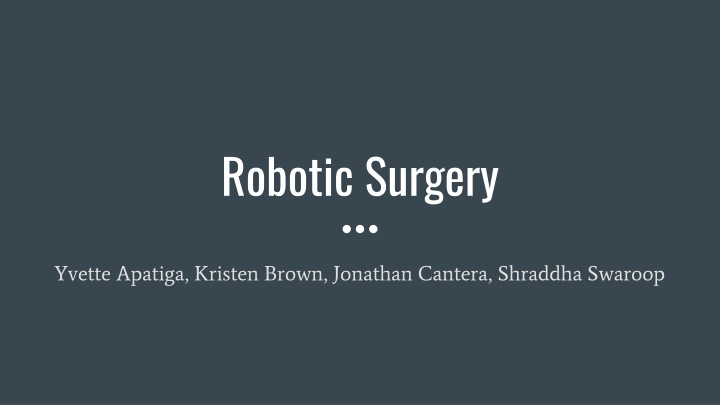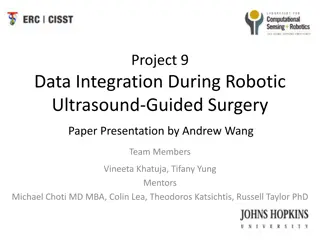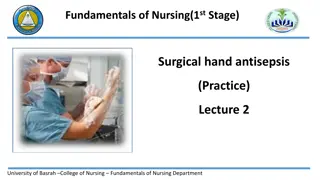Evolution of Robotic Surgery: Improving Surgical Precision and Efficiency
Robotic Assisted Surgery (RAS) has revolutionized the field of surgery by enhancing visual acuity, mobility, and reducing cognitive workload. The da Vinci Surgical System is at the forefront, offering high-definition imaging, immersive environments, and intuitive movements for better patient outcomes.
Download Presentation

Please find below an Image/Link to download the presentation.
The content on the website is provided AS IS for your information and personal use only. It may not be sold, licensed, or shared on other websites without obtaining consent from the author.If you encounter any issues during the download, it is possible that the publisher has removed the file from their server.
You are allowed to download the files provided on this website for personal or commercial use, subject to the condition that they are used lawfully. All files are the property of their respective owners.
The content on the website is provided AS IS for your information and personal use only. It may not be sold, licensed, or shared on other websites without obtaining consent from the author.
E N D
Presentation Transcript
Robotic Surgery Yvette Apatiga, Kristen Brown, Jonathan Cantera, Shraddha Swaroop
Introduction Minimally Invasive Surgery (MIS) A type of surgery approach performed to reduce recovery time through the use of small incisions Operate by inserting a laparoscope equipped with a camera, light source and surgical instruments Poor visual feedback and limited mobility
Introduction Robotic Assisted Surgery (RAS) Created to mitigate the limitations of MIS and provide Improved visual acuity Enhanced mobility The da Vinci Surgical System (dVSS) was the first RAS approved by the U.S. Food and Drug Administration for MIS in 2000
dVSS Vision console Surgeon console Patient cart
Theories: Usability A theoretical framework that relates to extent in which a system can be used by its intended user Usability evaluates the achievement of goals within certain contexts with: Effectiveness Efficiency Satisfaction
Theories: Systems Engineering Initiative For Patient Safety (SEIPS) Model
Key Issues: Cognitive Workload Limited capacity for cognitive resources High workload can increase risk for errors (Yuliya, Scerbo, Prabhu, Acker, & Stefanidis, 2010) RAS systems should aid surgeons to reduce mental demand (Moore, Wilson, McGrath, Waine, Masters, & Vine, 2014) Consideration of surgeon attributes (Hu, Lu, Tam, & Lomanto, 2016)
Practical Applications: Cognitive Workload Provides surgeons with high-definition 3D imaging for a better view of the patient s anatomy compared to traditional laparoscopic monitor displays. (Foo et al., 2013) Immersive environment prevents distraction (Sung & Gill, 2006) Intuitive movements and enhanced dexterity aids in laparoscopic tasks (Sung & Gill, 2006)
Current Issues: Cognitive Workload Increased complexity can negatively influence users with less experience in robotic laparoscopic surgery (Zhou, Cha, Gonzalez, Sundaram, Wachs, & Yu, 2019) Expertise aids cognitive workload (Zheng, Cassera, Martinec, Spaun, & Swanstr m, 2009) Consideration of individual differences in surgeon attributes Design recommendation Adaptive interface (Zhou, Cha, Gonzalez, Wachs, Sundaram, & Yu, 2018) Autonomous robotics in its infancy, but has the potential to enhance human-robot collaboration Figure from Zhou et al., 2019
Key Issues: Ergonomics MIS tools and monitor displays Uncomfortable posture Musculoskeletal concerns RAS far surpasses ergonomic demands Continued concern pertaining to neck strain
Practical Applications: Ergonomics dVSS provides surgeons well designed ergonomics: Adjustable forehead rest Armrest Update incluses saving specific surgeons ergonomic preferences Adjustable interface display
Current Issues: Ergonomics Closed console Leaning Neck strain Spine curvature; elbow strain Recommendations: 3D-HD mounted adjustable display 3D glasses for immersion Reduce neck and muscle strain
Key Issues: Situation awareness Situation awareness (SA) is defined as an operator s perception and understanding of how to do a task influenced by dynamic environmental information for current and future states (Endsley, 1995) (Endsley, 1995) Surgeons with lower SA are prone to make errors if they are unable to perceive and adequately assess the current state of the operation Team SA is another crucial component in the operating room that can influence performance outcomes (Stanton, Salmon, Walker, Salas, & Hancock, 2017) (Stanton, Salmon, Walker, Salas, & Hancock, 2017) Photo by J.C. Gellidon
Practical Applications: Situation awareness The dVSS is the front-runner of robotic surgery systems worldwide and include three multi- jointed wristed instruments, high definition 3-D camera that allows the surgeon to fully focus on target anatomy, eye tracking that zooms in on area surgeon is immersed in. These tools allow the surgeon to have full internal and external control of the tools used by the robot which assists the surgeon s SA by increasing visual acuity on the body area focused on
Current Issues: Situation Awareness Limitation: The current design forces surgeons to keep their heads down within a closed console. The closed console compromises SA because both the surgeon s vision and communication with the rest of the OR team becomes restricted (Chang et al., 2018) 2018). (Chang et al., Recommendation: Surgical teams using dVss should be required to implement readback during surgical operations Figure from Szeto et al., 2012
Application to Other Systems Anesthesia Machines Duties of the Anesthesiologist Provide continual medical assessment of patient Monitor and control patient vital life functions Control the patient s pain and level of consciousness Now with RAS - monitor RAS on patient and workaround it Implement Artificial Intelligence to aid Anesthesiologist with: Monitor and control anesthesia Produce event and risk predictions Aid in overall decision making
Application to Other Systems First Assistant Aid Duties of First Assistant: Robot docking Passing necessary materials Manipulate handheld instruments Aid with trocar planning and placement Implement optical see-through head-mounted display (OST-HMD) Head mounted display Virtual Stereo Monitor Endoscope Frustum
Thank You! Questions?
References Available upon request Contact: shraddhaswaroop@gmail.com























